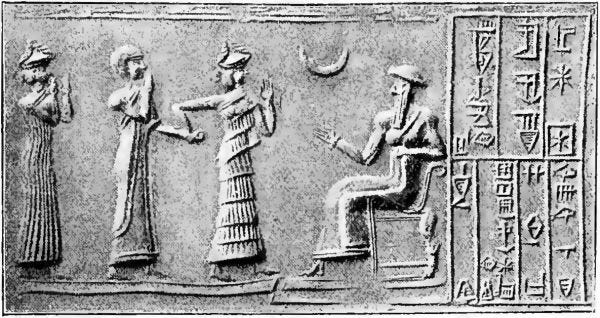Introduction to the Chemistry of Time
It is the Spring of 2024 in New York City, at the center of the global empire that has crowned over the entire world for generations as it has waved its wand of culture, finance, war, technology, and language. A cloudy and rainy dampness hangs over the city, insulating us for these hours against the cacophony to which we have all grown accustomed. There is nothing in living memory with which to compare the echoing shouts that come down daily – the sounds of war, financial ruin, social dissolution, and the shared and inescapable sense that we are being carried along on a cloud, un-anchored to the ground, in a balloon certain to run out of hot air at any moment. The people have retreated into distractions, preparations, and feverish discussions in the ill lit corners of our common spaces attempting to puzzle it all together – what is to come? What has happened? Where are we going? The inability to answer these questions fills the space of our rooms like a giant elephant, it’s trunk loaded with water and ready to spray us with humiliation for our failure to respond to the moment, to anticipate the twists, to see around the sharp curve ahead. The only consensus certainty is that the curve is very much ahead and that none of us knows what it will bring or know how to make sense of it if we did.
Suspended for four years in some manner of purgatory, The Americans and their subjects are on the razor’s edge, dangling out over the limb of the future feeling very much like a cartoon coyote who has over run the ledge. The metaphors have mixed, and confuse. Information cults compete for their attention and their energy – they compete for their minds. And what minds are left? Are they real or are they artificial creations or are they altered by algorithms? And where is the alter of our ancestors which carried them through the turnings they have described for us in their texts? In this moment, between the eclipses, the lights have failed to illuminate the path ahead, with the sharp curve near, and seemingly nothing sure and certain and determined exists to show us the way. This is the way it seems, the way it presents itself, and the way it is reflected to us. But it is not so.
As it turns out an effective tool for managing these circumstances does exist and lingers in plain sight. That tool is a calendar and is based upon movements that are beyond our alteration. It retains high precision deep into the past and into the future and has been used throughout history for extremely important endeavors. Its common use has ebbed and flowed with the centuries, in concert with access to information, and its influence is widely seen and recognized even today. That calendar is the Hellenistic Astrological Calendar, the /Horoskopos/ system. Most today are familiar with something they call “astrology” but which is in fact a second or third order practice that derives from this ancient calendar system. While there is utility in much of the knowledge contained in that “astrology” it is not commonly used or spoken of within the proper context of its origins and real utility and it is widely conflated with cultural legacies from both past eras and today. For that reason, I ask you to first forget whatever present understanding you may have of this field and to allow yourself to understand it as presented here.
The initial origins of this calendar system are rather murky, but we have documentation dating back thousands of years attesting to it in some form or another. These earliest attestations are found in ancient Babylon, Egypt, Persia, and India, but it was the Hellenistic Greek civilization (>320 BC) which appears to have most recently formulated and collected the knowledge and produced the documentation for it that survives into today. In the post-Hellenistic centuries this information again fractured, persisting in pockets and varying degrees of completeness throughout the Medieval and Renaissance period with periodic revivals. It is only in the 21st century, through great efforts to catalog and translate surviving texts, that the system has been again reassembled to the degree to which it was understood in the Hellenistic era. Additional factors created by modern technology have made the present time the premier era in recorded history in terms of totality of understanding and ability to work with and utilize this system. The moment for this calendar has very much arrived (and from the looks of what it shows us, at just a moment when we can really benefit from it).
Beyond the core calendar function we must also understand that astrology is a system. This is a calendar with a system for interpreting what the calendar shows and that system is well-organized, categorized, and defined. It operates on clear rules which reinforce each other and which together form a remarkably elegant structure – this is undoubtedly something that was created or delineated by people of deep scientific understanding and knowledge. The system itself reveals a very high level of understanding of formative principles at work in this world for which we do not have any true equivalent, but to which I think is best compared to a sort of chemistry for time itself. The comparison is actually rather modest and is one that you will increasingly appreciate as you gain understanding of the workings of the system. At its core the system is breaking down the moments and eras of time into component elements and explaining the rules for how they interact with each other and what effects that will produce in the external world. The system is built upon two sets of base elements, one that represents active elements and another that represents terrain elements. Information is derived by considering the interaction of these terrain elements with active elements, as well as the interactions between base elements themselves. Additionally, locality of these interaction is of great importance. The calendar is utilized to identify the changing locations, modalities, and interactions of these elements at a particular time and the system enables us to interpret what the character and events of that particular time will be as a result of those interactions.
Does this system work to provide what it promises to? Yes, it very much does and this fact can be demonstrated to anyone by a skilled practitioner in less than fifteen minutes. The long history of this system being utilized in a surprising range of civilizations – with documented results – further attests to its effectiveness. There is no doubt of the accuracy of the calendar itself, in fact it is far superior to our common Gregorian calendar, and there is no case where the system has been evaluated in a rigorous manner and shown to be false. Rather than being considered false, the system has historically been regarded as effective and was often suppressed and opposed by institutional power specifically because of that effectiveness and and the implications thereof. In some cases, as with any tool, it has been used improperly, or more often incorrectly. Ultimately it is a system with a great degree of precision but which is subject to the skill and discipline of the interpreter. The inadequacy of a practitioner in any field is not a condemnation of that field of knowledge and practice itself, and that same understanding must be applied to astrology in this context. Finally – the answer to the question of functionality is one that becomes rapidly self-evident upon utilization of the system to the point of making it a moot point.
Is the system useful? Tremendously so, to a degree that is difficult to overstate. The usefulness of the system is vast and profound and with deep implications to our understanding of our world, our life, and time itself. The power of this knowledge has long been understood and is related to the waxing and waning of its utilization through the centuries. In many periods, the knowledge of this system was deliberately hidden (kept within a sort of guild) and shared only with those deemed prepared to grapple with its implications. This contributed greatly to the limited documentation and likely the limited understanding of its origins. This was increasingly complicated by the manner in which information was passed down in the past and the difficulties that derive from that. Precise technical documents that undergo multiple copying, translation, and oral transmission (over many centuries) can become very difficult to interpret. This problem is paramount to the incomplete understanding of astrology in most recorded and modern history, and is the basis for the second and third-effect derivations which form the common popular understanding of the system today. Lastly, it is likely that the true origin of the calendar and system is much older than anticipated, and that methods of oral transmission which were used to preserve information in a precise way over extremely long periods of time introduced certain gaps in understanding which are possibly only now being filled. While the Hellenistic period is presently credited with the innovation of this system I believe it is more likely that the Hellenistic product is one of re-creation of an even older system, similar to what has occurred in the modern day. Few bodies of knowledge have ever been collected, transmitted, and preserved in this way, and each of them deals with profoundly useful core understandings of our world itself. As such, the astrological system should be considered to have been of primary importance to those who first possessed it and the preservation of the knowledge was treated in accordance with that. It is as if ancient peoples were asked “which three books would you take with you to an isolated island,” and the book of the astrological system was selected as one of those three. Is it useful? Apparently the people of the past thought so, and that is why we still have this knowledge today.


Leave a Reply